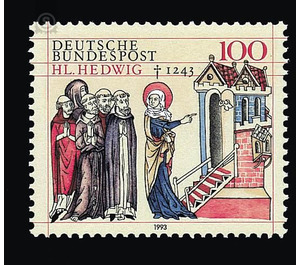750th anniversary of death of St.Hedwig - Germany / Federal Republic of Germany 1993 - 100 Pfennig
Theme: Art & Culture
| Country | Germany / Federal Republic of Germany |
| Issue Date | 1993 |
| Face Value | 100.00 |
| Color | multi-colored yellow |
| Perforation | K 14:13 3/4 |
| Printing Type | Multicolor offset printing |
| Stamp Type | Postage stamp |
| Item Type | Stamp |
| Chronological Issue Number | 1574 |
| Chronological Chapter | GER-BRD |
| Michel ID | BRD 1701 |
| SID | 95070 |
| In 39 Wishlists | |
In 1993, the 750th anniversary of the death of St. Hedwig of Silesia. Born in 1174 as the daughter of Count Berthold IV of Andechs, she was married at the age of 13 to Duke Henry I of Silesia, from the Silesian line of the oldest Polish dynasty of Piast peoples. She was the mother of seven children, but only her daughter Gertrud survived. Her son Duke Henry II fell in 1241 in the battle of Liegnitz against the Tatars. At the side of her husband, Hedwig was a blessing for the whole country. Her special concerns included the consolidation and deepening of Christian life and the cultural promotion of Silesia. It praises the foresight and organizational talent of the mother of the country, her cleverness, firmness and extraordinary piety. She was particularly distinguished by an ascetic lifestyle and exemplified Christian charity. In it she was, as it is documented by a multitude of legends, equal to her niece, St. Elizabeth of Thuringia, and a model for the whole people. This is impressively illustrated by the so-called Schlackenwerther Codex from 1353, the oldest picture manuscript for her life. Hedwig died on October 14, 1243. She was buried in her favorite foundation, the Cistercian Convent Trebnitz; this first nunnery in Silesia had been founded in 1203 at the instigation of Duke Henry I; It soon became a much visited pilgrimage site after her death. On March 26, 1267, she was canonized by Pope Clement IV. The Holy Duchess of Silesia is still one of the most popular saints of the German-Bohemian-Polish region. She is the patron saint of the Hedwig sisters, a charitable cooperative founded in Wroclaw in 1859, whose sisters are especially dedicated to the education of the youth and the care of sick, old and dependent people. It is alive also in the Silesian customs; Hedwig's soles, a Silesian pastry eaten on Hedwig's Day, are reminiscent of the asceticism of the saints, who went barefoot to the poor and distributed alms. Saint Hedwig worked in a time that did not yet know any dividing national boundaries. Today she is equally revered by Poles and Germans, a mediator between the two peoples. When Pope John Paul II celebrated Holy Mass on his second pilgrimage through Poland in Wroclaw on June 21, 1983, he said in his homily: "In Polish and European history, St. Hedwig stands as a frontier figure that unites two nations : the German and the Polish nation. It connects them over many centuries of a story that was difficult and painful. In the midst of all historical trials, St. Hedwig has for seven centuries been the advocate of mutual understanding and reconciliation in accordance with the requirements of the rights of the people, international justice and peace. «(Text: Commissariat of German Bishops, Bonn)
| Condition | Name | In Stock | Price | Price + Shipping | Store | |
|---|---|---|---|---|---|---|
 | Unmounted Mint ** | 750th anniversary of death of St.Hedwig - Germany / Federal Republic of Germany 1993 - 100 Pfennig | 2 | US $1.07 | US $4.26 |  FILATELIELOKET (0) FILATELIELOKET (0)Shipping US $3.19 Minimum Order US $2.67 |


